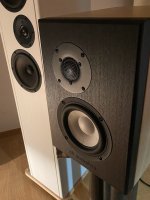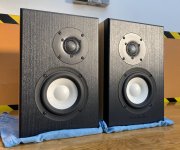Are his tweeter and midrange 6 inches center-to-center at a 4,500Hz crossover? That would be a 76mm wavelength x a multiplier of 2 = 152 mm c-t-c.
From the link above
- Split frequencies: 500Hz (lower bass-middle sound) and 2950 Hz
Crossover is 2950Hz. So if the drivers are 6 inches (big IF, because I can't tell from the photo) c-t-c it is a 1.3 multiplier.
Technical information:
Operating principle: 2.5-way, passive radiators
Elements: Purifi Audio 6.5" bass-midrange 2pcs, Purifi Audio 6.5" passive radiator 4pcs and SB Acoustics 29mm Babyllium cap
Dimensions (W x H x D): 210 x 1000 x 300mm
Volume: 28 liters net
Case material: MDF
Playback range: 33 - 24000 Hz, -6dB
Split frequencies: 310Hz (lower bass-mid tone) and 2950 Hz
Amplifier power: 245+245+245 W, treble protection level 100/140 W RMS/peak
Connections: Analog XLR, AES/EBU XLR, USB type B (equalization)
Power connector: IEC C14
Cooling: Passive (no fan)
Cognitive correction: with the FourAudio System application, Windows or macOS
Made in Finland
https://audiokauppa.fi/products/taipuu-kero-l-active-pro-lattiakaiutinpari
Technical information:
Operating principle: 2.5-way, passive radiators
Elements: Purifi Audio 6.5" bass-midrange 2pcs, Purifi Audio 6.5" passive radiator 4pcs and SB Acoustics 29mm Babyllium cap
Dimensions (W x H x D): 210 x 1000 x 300mm
Volume: 28 liters net
Case material: MDF
Playback range: 33 - 24000 Hz, -6dB
Split frequencies: 310Hz (lower bass-mid tone) and 2950 Hz
Amplifier power: 245+245+245 W, treble protection level 100/140 W RMS/peak
Connections: Analog XLR, AES/EBU XLR, USB type B (equalization)
Power connector: IEC C14
Cooling: Passive (no fan)
Cognitive correction: with the FourAudio System application, Windows or macOS
Made in Finland
https://audiokauppa.fi/products/taipuu-kero-l-active-pro-lattiakaiutinpari
As everyone has already pointed out, I think the speaker that I posted the graphs for are for the active version of the speaker. But they also discuss about the availability of a passive version and I am more interested in the details of that version as well..
@hifijim: Thanks a lot for the analysis. It is precisely the feature that you highlighted that I was most interested in in the curves. That wide and shallow on axis dip. This is because you had designed a crossover version for my 3 way system with the SB 15CAC + SB26CDC in a 4inch augerpro waveguide and we had graphs like this.

The on axis response trend looks close to Kimmosto's design but the dip is a little less on this one. We probably just had to spread the dip over a wider area like Kimmosto has done and check what are the differences.. 🙂
Unfortunately I didn't try out the above crossover last year since I had moved on to the wavecor 4.5inch mid driver.. I definitely have some motivation now to revisit that design and hear what it sounds like.. 🙂
Kimmosto says that he prefers non waveguided tweeters... Since you have compared waveguided vs non waveguided 2/3ways speakers, what is your impression about these two kind of speakers in terms of how they sound?
I haven't heard a well designed non waveguided tweeter based speaker in a long time and I have forgotten how it can sound.
Another point that Kimmosto brings up is quality of components. About the purifi midwoofer, I can understand how it is superior to many other similar diameter woofers in different ways but what about the SB beryllium tweeter used in the design. Is there a marked difference in sound quality of a beryllium tweeter compared to others?
I have never heard a beryllium tweeter.
@hifijim: Thanks a lot for the analysis. It is precisely the feature that you highlighted that I was most interested in in the curves. That wide and shallow on axis dip. This is because you had designed a crossover version for my 3 way system with the SB 15CAC + SB26CDC in a 4inch augerpro waveguide and we had graphs like this.
The on axis response trend looks close to Kimmosto's design but the dip is a little less on this one. We probably just had to spread the dip over a wider area like Kimmosto has done and check what are the differences.. 🙂
Unfortunately I didn't try out the above crossover last year since I had moved on to the wavecor 4.5inch mid driver.. I definitely have some motivation now to revisit that design and hear what it sounds like.. 🙂
Kimmosto says that he prefers non waveguided tweeters... Since you have compared waveguided vs non waveguided 2/3ways speakers, what is your impression about these two kind of speakers in terms of how they sound?
I haven't heard a well designed non waveguided tweeter based speaker in a long time and I have forgotten how it can sound.
Another point that Kimmosto brings up is quality of components. About the purifi midwoofer, I can understand how it is superior to many other similar diameter woofers in different ways but what about the SB beryllium tweeter used in the design. Is there a marked difference in sound quality of a beryllium tweeter compared to others?
I have never heard a beryllium tweeter.
I heard, exactly this one like in this Taipuu speaker. In one of modifications of Bagby's Revolution. It had enormous unobtrusive resolution...you could hear everything even on very low levels....It was really fascinating,...I'm thinking to buy a pair, but don't know which, Bliesma is end of life, Scans are geting unavailable and there are still SB's everywhere to buy...they are also the cheapest so probably will be SB...
Attachments
That filter design is from post #709, yes? I was aiming for a smoothly dropping PIR (in-room) response and a smoothly dropping power response.
Regarding waveguide vs non-waveguide:
I am going to paraphrase what I wrote here comparing my Satori Textreme system to the Purifi + Beryllium waveguide tweeter system.
https://www.diyaudio.com/community/threads/purifi-waveguide-project.394174/post-7404653
My first subjective evaluations were that the Purifi-waveguide had more precise localizations. The presentation of depth was better, meaning distant sounds appeared further away, and close sounds appeared more near, compared to the TX. The soundstage was as wide as the speakers, but not wider. The TX system had a somewhat less precise localization, slightly less range of depth, and a wider soundstage that extended well past the speakers. The illusion of width that extends much wider than the speakers can be very enjoyable.
When playing correlated pink noise on the Purifi-waveguide, the phantom mono image was about the size of soccer ball. With the TX, it was about the size of the TV screen. When playing uncorrelated pink noise on the Purifi-waveguide, the diffuse sound was as wide as the speakers and evenly distributed. With the TX, it wrapped around the sides of the room well beyond the width of the speakers. It was almost 180 degrees laterally distributed relative to the listening position.
Then I started adjusting the listening distance. When listening to the TX, if I moved forward by 24 inches, it seemed to be very similar to the Purifi-waveguide. Image localization became more focussed, depth perception increased, and soundstage width narrowed. When listening to the Purifi-waveguide, if I moved back by about 36 inches, it sounded a lot like the TX. More enveloping, wider soundstage, but a more diffuse image with less precise localization and depth.
So to me it is very interesting that I can subjectively replicate the effect of a higher directivity waveguide speaker by using a wider dispersion speaker and a closer listening position. I am convinced it all comes down to the ratio of direct to reflected sounds. Higher directivity increase the ratio of direct to reflected, but so does a closer listening distance.
At this point, I have no preference. On some recordings, the TX system is preferable. On others, the Purifi-waveguide is preferable. On many recordings, I do not prefer one to the other, even though they sound slightly different.
Regarding beryllium tweeters: I have experience listening to two beryllium tweeters, a Bliesma T25B and a Satori TW29BNWG. In my opinion, they are very good tweeters, but they are not better than the Satori TW29TXN-B. The textreme tweeter is equal in terms of detail, clarity, resolution, and natural relaxed presentation. With our current supply issues with beryllium foil, I see no issues at all with using a textreme diaphragm driver as a substitute.
Regarding waveguide vs non-waveguide:
I am going to paraphrase what I wrote here comparing my Satori Textreme system to the Purifi + Beryllium waveguide tweeter system.
https://www.diyaudio.com/community/threads/purifi-waveguide-project.394174/post-7404653
My first subjective evaluations were that the Purifi-waveguide had more precise localizations. The presentation of depth was better, meaning distant sounds appeared further away, and close sounds appeared more near, compared to the TX. The soundstage was as wide as the speakers, but not wider. The TX system had a somewhat less precise localization, slightly less range of depth, and a wider soundstage that extended well past the speakers. The illusion of width that extends much wider than the speakers can be very enjoyable.
When playing correlated pink noise on the Purifi-waveguide, the phantom mono image was about the size of soccer ball. With the TX, it was about the size of the TV screen. When playing uncorrelated pink noise on the Purifi-waveguide, the diffuse sound was as wide as the speakers and evenly distributed. With the TX, it wrapped around the sides of the room well beyond the width of the speakers. It was almost 180 degrees laterally distributed relative to the listening position.
Then I started adjusting the listening distance. When listening to the TX, if I moved forward by 24 inches, it seemed to be very similar to the Purifi-waveguide. Image localization became more focussed, depth perception increased, and soundstage width narrowed. When listening to the Purifi-waveguide, if I moved back by about 36 inches, it sounded a lot like the TX. More enveloping, wider soundstage, but a more diffuse image with less precise localization and depth.
So to me it is very interesting that I can subjectively replicate the effect of a higher directivity waveguide speaker by using a wider dispersion speaker and a closer listening position. I am convinced it all comes down to the ratio of direct to reflected sounds. Higher directivity increase the ratio of direct to reflected, but so does a closer listening distance.
At this point, I have no preference. On some recordings, the TX system is preferable. On others, the Purifi-waveguide is preferable. On many recordings, I do not prefer one to the other, even though they sound slightly different.
Regarding beryllium tweeters: I have experience listening to two beryllium tweeters, a Bliesma T25B and a Satori TW29BNWG. In my opinion, they are very good tweeters, but they are not better than the Satori TW29TXN-B. The textreme tweeter is equal in terms of detail, clarity, resolution, and natural relaxed presentation. With our current supply issues with beryllium foil, I see no issues at all with using a textreme diaphragm driver as a substitute.
Thanks a lot for this comparison @hifijim 🙂
I guess I should save up for one last speaker project (if there is ever such a thing) with a purifi driver and some beryllium/textreme tweeter.. 🙂 (by the way, here in India the SB textreme & beryllium tweeters cost about the same, at least for now). That needs quite a bit of money though.. 😀
If not for anything else, just to experience such a combination sounds different compared to all the other normal speakers I have.. 🙂
I guess I should save up for one last speaker project (if there is ever such a thing) with a purifi driver and some beryllium/textreme tweeter.. 🙂 (by the way, here in India the SB textreme & beryllium tweeters cost about the same, at least for now). That needs quite a bit of money though.. 😀
If not for anything else, just to experience such a combination sounds different compared to all the other normal speakers I have.. 🙂
I think I should also mention this... In my opinion, expensive tweeters offer less "bang for the buck" compared to midrange and woofer drivers. A very good tweeter can be bought for $50 - $150, and the difference between these and an exotic $500 beryllium tweeter is not that big. It is much wiser to spend big on woofers and midrange drivers and then save a bit of money on the tweeter.
For example, I would have no qualms about using a Seas 27TBCD/GB-DXT or SB26CDC in combination with a much more expensive midwoofer or midrange.
For example, I would have no qualms about using a Seas 27TBCD/GB-DXT or SB26CDC in combination with a much more expensive midwoofer or midrange.
What’s the pattern width of the Purifi waveguide, Jim?
Also, Kimmo’s cons for waveguides are a bit obscure, as often with his thinking. Would weight it in too much unless a detailed explanation follows.
Also, Kimmo’s cons for waveguides are a bit obscure, as often with his thinking. Would weight it in too much unless a detailed explanation follows.
What’s the pattern width of the Purifi waveguide,
The satori waveguide is 170 mm, and my circular housing is 245 mm with a 37 mm circular edge radius. Is that what you are asking?
Let's not go too far off topic in Vineeth's thread. If you want to know more about my project, ask me questions in that thread... https://www.diyaudio.com/community/threads/purifi-waveguide-project.394174/post-7226601
j.
This makes your previous subjective experience that of a 90 degree horizontal 1k-5k waveguide, narrowing considerably above. The matter with waveguides is most are stupidly narrow, we do not need this for HiFi listening.
To me this is too obscure. There is not even an argument in it besides to give in to convention and habbit. Why even consider, I don't see any value.
Kimmo said:Designer and many listeners happens to prefer conventional tweeters so visually perfectly linear DI response is not primary target with 6.5" mid-woofer.
To me this is too obscure. There is not even an argument in it besides to give in to convention and habbit. Why even consider, I don't see any value.
I have never met Kimmo or heard any of his designs, but to me that opinion is valid, as an opinion of an experienced and well regarded desiger. It is not a statement or de facto.
I think that many designers now are way too obsessed to get PIR and DI straight (or straight line). We must remember that a good loudspeaker must sound "right" in normal listening environment - so "voicing" is the final goal, not how measurements look!
I think that many designers now are way too obsessed to get PIR and DI straight (or straight line). We must remember that a good loudspeaker must sound "right" in normal listening environment - so "voicing" is the final goal, not how measurements look!
But that's not what he wrote in this quote from a conversation that we don't have the other pieces from.
He said that Directivity (Index) can be regarded less important than SP and on-axis (direct sound, say Listening Window), not that it does not matter. If SP and on-axis (LW) are well balanced and DI seems off, he would suggest that is not a major issue then.
This was not about voicing. And look at the direct sound: it's compromised, due to the correction of overly bright presentation that would occur with a flat on-axis response due to excessive off-axis energy. It's not 'voiced'. A moderately wide waveguide would mitigate this. And the precise speaker example looks pretty much PIR optimized to me.
He said that Directivity (Index) can be regarded less important than SP and on-axis (direct sound, say Listening Window), not that it does not matter. If SP and on-axis (LW) are well balanced and DI seems off, he would suggest that is not a major issue then.
This was not about voicing. And look at the direct sound: it's compromised, due to the correction of overly bright presentation that would occur with a flat on-axis response due to excessive off-axis energy. It's not 'voiced'. A moderately wide waveguide would mitigate this. And the precise speaker example looks pretty much PIR optimized to me.
I am not sure what you mean... Are you suggesting my subjective evaluation is valid, or not valid, because of the width of the waveguide... or are you suggesting something else? Sorry for my confusion...This makes your previous subjective experience that of a 90 degree horizontal 1k-5k waveguide, narrowing considerably above. The matter with waveguides is most are stupidly narrow, we do not need this for HiFi listening.
This was not about voicing. And look at the direct sound: it's compromised, due to the correction of overly bright presentation that would occur with a flat on-axis response due to excessive off-axis energy. It's not 'voiced'. A moderately wide waveguide would mitigate this. And the precise speaker example looks pretty much PIR optimized to me.
I respectfully disagree. This is exactly what voicing is all about. When I tweak a speaker's response, I often try to optimize various derived curves, such as the PIR or the sound power, and see what I like best. Sometimes it is a compromise.
I don't find Kimmo's thoughts to be obscure. But I also keep in mind that he is a professional audio designer, and because of that he will have certain trade secrets and intellectual property that he is not able to share with us in a DIY forum.
Over the years, Kimmosto has explained some of his reasons for preferring non waveguided HF more I think over at different forums. One such post I could find was this:
https://audiosciencereview.com/forum/index.php?threads/neumann-kh150.33454/post-1364894
I might be too inexperienced for me to comment about directivity step from Mods to highs related effects, but one thing I have been recently noticing from listening to my cardioid mid system vs my bigger Satori 2x WO24P + ST260 KVAR based system is that the cardioid mid system sounds more "natural". on comparing, the bigger system feels like having ultra high resolution in the highs but not so much in the lows.. I am unable to comment about the mids since I am still evaluating/learning about it..
As of now, I think what Kimmosto says about large directivity steps is one of the reasons behind this phenomenon though I am not sure about anything now. In my case it could even be that the waveguide, which has been designed for larger diameter woofers is forcibly made to work with 2x9 ish inch woofers.
A lot of other reasons might also be at work. But the directivity step reason is another reason why I want to experiment with a 15inch driver in cardioid enclosure with a bigger horn 🙂
I know it doesn't even come close to Kimmosto's 2x18inch driver based cardioid+horn combination but atleast give me some idea about whether I am imagining things or not 😀
PS: I think definitely more of us should start building cardioid-based systems and evaluate our preferences now that the cardioid building/design voodoo is a little simplified
https://audiosciencereview.com/forum/index.php?threads/neumann-kh150.33454/post-1364894
I might be too inexperienced for me to comment about directivity step from Mods to highs related effects, but one thing I have been recently noticing from listening to my cardioid mid system vs my bigger Satori 2x WO24P + ST260 KVAR based system is that the cardioid mid system sounds more "natural". on comparing, the bigger system feels like having ultra high resolution in the highs but not so much in the lows.. I am unable to comment about the mids since I am still evaluating/learning about it..
As of now, I think what Kimmosto says about large directivity steps is one of the reasons behind this phenomenon though I am not sure about anything now. In my case it could even be that the waveguide, which has been designed for larger diameter woofers is forcibly made to work with 2x9 ish inch woofers.
A lot of other reasons might also be at work. But the directivity step reason is another reason why I want to experiment with a 15inch driver in cardioid enclosure with a bigger horn 🙂
I know it doesn't even come close to Kimmosto's 2x18inch driver based cardioid+horn combination but atleast give me some idea about whether I am imagining things or not 😀
PS: I think definitely more of us should start building cardioid-based systems and evaluate our preferences now that the cardioid building/design voodoo is a little simplified
Last edited:
With that, a glimpse of the EXAR 400 right from the printer before any post-processing and painting 😉



Edit time over, so I am writing a separate post about what I intended to write in the above post.
Anything that Kimmosto says about speaker design carries a lot of weight to me. If not for other reasons, just for the reason that nobody else I know have built so many speakers and speaker concepts and actually heard them and evaluated them along with the graphs.
This is unlike some people I know who just get fixated on the graphs only and decide things solely based on that with no first-hand experience building systems and experiencing them.
If there is anything I have learned over the course of getting a PhD and 5 years of R&D in the industry/academia, it is that all data/graphs can be made to look nice. Often, it is only when that data is put in the right context that the data makes any sense. IMO, with speaker design, that context comes from building systems and experiencing them 🙂
Anything that Kimmosto says about speaker design carries a lot of weight to me. If not for other reasons, just for the reason that nobody else I know have built so many speakers and speaker concepts and actually heard them and evaluated them along with the graphs.
This is unlike some people I know who just get fixated on the graphs only and decide things solely based on that with no first-hand experience building systems and experiencing them.
If there is anything I have learned over the course of getting a PhD and 5 years of R&D in the industry/academia, it is that all data/graphs can be made to look nice. Often, it is only when that data is put in the right context that the data makes any sense. IMO, with speaker design, that context comes from building systems and experiencing them 🙂
Kimmosto's Taipuu 2.5 Purifi design is 180 degree polar pattern. Similar to his other conventional tweeter Taipuu 4-way design he looks like he focused on achieving smooth down-sloping total ER and power response but with different deflection points. https://taipuuspeakers.fi/en/taipuu-speakers-dsp-active-speakers/
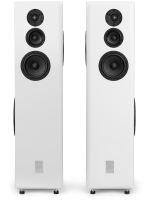
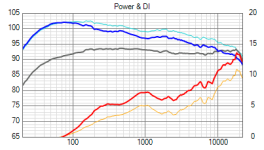
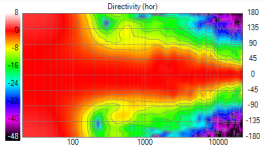
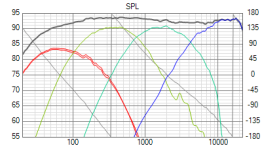
He also has a Taipuu 90 degree two-way polar pattern design with a compression driver waveguide (coaxial woofer cone).
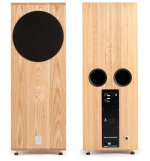
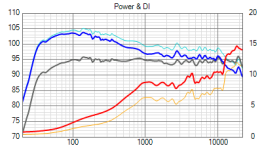
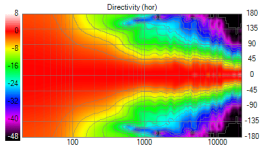
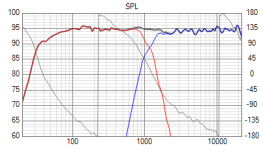
And a Taipuu 90 degree three-way with a compression driver waveguide (coaxial woofer cone)
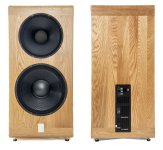
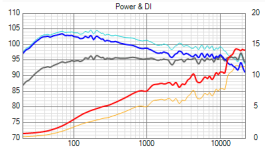
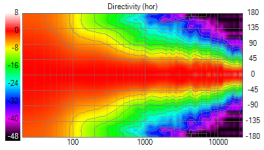
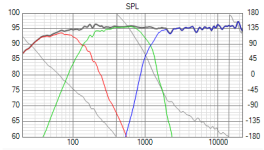
In addition, here's the Genelec 8381A.
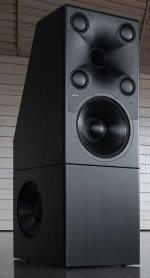
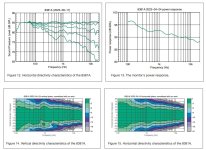
A set of top rate no holds barred examples from Finland to analyze.




He also has a Taipuu 90 degree two-way polar pattern design with a compression driver waveguide (coaxial woofer cone).




And a Taipuu 90 degree three-way with a compression driver waveguide (coaxial woofer cone)




In addition, here's the Genelec 8381A.


A set of top rate no holds barred examples from Finland to analyze.
Last edited:
- Home
- Loudspeakers
- Multi-Way
- A 3 way design study
